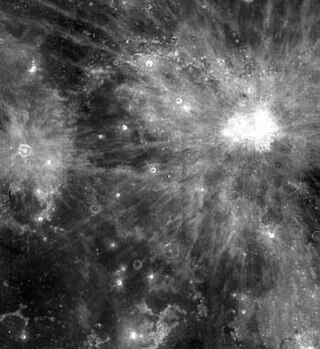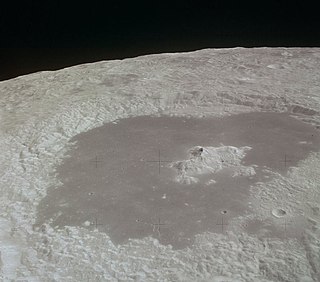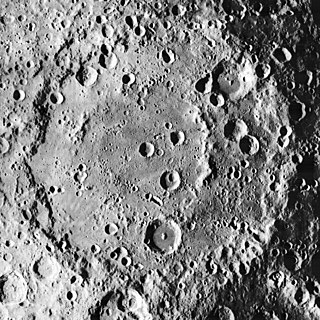
Mare Insularum is a lunar mare located in the Insularum basin just south of the western Mare Imbrium. The basin material is of the Lower Imbrian epoch, with the mare material of the Upper Imbrian epoch. The mare is bordered by the craters Copernicus on the east, and Kepler on the west. Oceanus Procellarum joins the mare to the southwest.

Mare Moscoviense is a lunar mare that sits in the Moscoviense basin. It is one of the very few maria on the far side of the Moon. Like Mare Marginis, this mare appears to be fairly thin. However, it is clearly centered within a large impact basin. It is also much lower than either the outer basin floor or the farside highlands.

Mare Nubium is a lunar mare in the Nubium basin on the Moon's near side. The mare is located just to the southeast of Oceanus Procellarum.

Alphonsus is an ancient impact crater on the Moon that dates from the pre-Nectarian era. It is located on the lunar highlands on the eastern end of Mare Nubium, west of the Imbrian Highlands, and slightly overlaps the crater Ptolemaeus to the north. To the southwest is the smaller Alpetragius. The crater name was approved by the IAU in 1935.

Harold (Hal) Masursky was an American astrogeologist.

Brayley is a lunar impact crater located in the southwest part of the Mare Imbrium. It was named after British geographer Edward W. Brayley in 1935. It has a circular rim and a low rise in the center. There are no notable craters overlapping the rim or interior. The sinuous rille Rima Brayley passes to the north of Brayley.

Censorinus is a 3.8 km lunar impact crater located on a rise to the southeast of the Mare Tranquillitatis. It is named after the ancient Roman writer Censorinus. To the northeast is the crater Maskelyne.

Petavius is a large lunar impact crater located to the southeast of the Mare Fecunditatis, near the southeastern lunar limb. Attached to the northwest rim is the smaller crater Wrottesley. To the southeast are Palitzsch, Vallis Palitzsch, and Hase. Farther to the north is the large crater Vendelinus. Petavius appears oblong when viewed from the Earth due to foreshortening. Petavius is Imbrian in age.

Proclus is a young lunar impact crater located to the west of the Mare Crisium, on the east shore of the Palus Somni. Its diameter is 27 km. It was named after 5th century Greek mathematician, astronomer and philosopher Proclus.

Lansberg is a lunar impact crater on the Mare Insularum. It can be located by following a line south-southwest from Copernicus to Reinhold, then southwest to Lansberg. The crater has a high rim and a central mountain. There are terraces along the inner walls, and the tops have slumped to produce a sharp edge. This formation is not noticeably eroded, and there are no significant impact craters within the interior.

Tsiolkovskiy is a large lunar impact crater that is located on the far side of the Moon. Named for Russian scientist Konstantin Tsiolkovsky, it lies in the southern hemisphere, to the west of the large crater Gagarin, and northwest of Milne. Just to the south is Waterman, with Neujmin to the south-southwest. The crater protrudes into the neighbouring Fermi, an older crater of comparable size that does not have a lava-flooded floor.

Van de Graaff is a crater formation located on the far side of the Moon, on the northeast edge of Mare Ingenii.

Korolev is a large lunar impact crater of the walled plain or basin type. It is a basin of Nectarian age.

King is a prominent lunar impact crater that is located on the far side of the Moon, and can not be viewed directly from Earth. The crater was named after Arthur Scott King and Edward Skinner King in 1970. Prior to that, this crater was known as Crater 211. It forms a pair with Ibn Firnas, which is only slightly larger and is attached to the northeast rim of King. To the northwest is the crater Lobachevskiy, and Guyot is located an equal distance to the north-northwest.

Cayley is a small lunar impact crater that is located in a lava-flooded region to the west of Mare Tranquillitatis. It was named after the 19th-century English mathematician Arthur Cayley. It lies to the northwest of the smaller crater De Morgan and the larger D'Arrest. West and slightly north of Cayley is Whewell, a crater of about the same dimensions. To the north is a linear rille designated Rima Ariadaeus, which follows a course to the east-southeast.

Peirce is a small lunar impact crater in the western part of Mare Crisium. That dark, circular lunar mare is located in the east-northeasterly part of the Moon's near side. It was named after the American mathematician Benjamin Peirce. Peirce lies to the north of the craters Yerkes and Picard, and southeast of Macrobius located outside the mare. Just over a crater diameter to the north of Peirce is the smaller Swift. To the northwest is the wrinkle ridge Dorsum Oppel.

Necho is a lunar impact crater on the far side of the Moon, and therefore cannot be seen directly from the Earth. It lies to the northeast of the larger crater Langemak, about a crater diameter to the south-southwest of Bečvář and further east is Love.

The Astrogeology Science Center is the entity within the United States Geological Survey concerned with the study of planetary geology and planetary cartography. It is housed in the Shoemaker Building in Flagstaff, Arizona. The Center was established in 1963 by Eugene Merle Shoemaker to provide lunar geologic mapping and to assist in training astronauts destined for the Moon as part of the Apollo program.

Lunar Sample 15016, better known as the "Seatbelt Basalt", is a lunar sample discovered and collected on the Apollo 15 mission in 1971 in the Hadley-Apennine region of the Moon. The rock is a 0.923 kg (2.03 lb) vesicular olivine basalt.

David Holcomb Scott was an American geologist who worked for the U.S. Geological Survey's Center of Astrogeology in Flagstaff, Arizona. Scott was involved in the Apollo Program, and served as project chief for the Mars geologic mapping program, which was funded by NASA's Planetology Program Office. He continued to publish scientific articles on Mars through the 1990s.





















